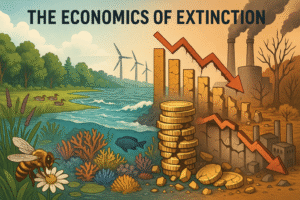As we continue our exploration into India’s economic ascent, this second installment focuses on the challenges and future prospects facing India as it strides towards becoming an economic superpower. Despite impressive growth and potential, India confronts a blend of domestic and global hurdles.
Navigating Global and Domestic Challenges
- The Economic Slowdown Ahead
- Oxford Economics predicts a slowdown in India’s GDP growth to 5.7% in 2024, influenced by a mix of cyclical and structural themes. Consumer spending and public expenditure are expected to feel the pandemic’s lingering effects, and labor market distress could further squeeze spending capabilities.
- Inflation and Monetary Policy
- The Reserve Bank of India (RBI) anticipates a soft landing in the face of inflationary pressures, with expected average CPI inflation at 4.5% next year. The RBI’s commitment to stabilizing inflation may shape its monetary policy actions in 2024.
- The Demographic Dividend Challenge
- India’s demographic advantage, with about 60% of its population soon expected to be of working age, presents both an opportunity and a challenge. Leveraging this demographic dividend requires structural improvements, particularly in job creation suitable for its youthful population.
India’s Economic Growth Prospects
- Investment and Multinational Interest
- India is poised to be a strong performer in terms of investment, with government infrastructure projects and growing interest from multinationals. The country is increasingly seen as a key alternative manufacturing base amid global supply chain diversification strategies.
- CEO Confidence in Economic Improvement
- PwC’s Annual Global CEO Survey highlights that 86% of Indian CEOs believe India’s economic growth will improve over the next 12 months. This optimism contrasts with a more cautious global outlook, reinforcing India’s growing economic stature.
- Risks and External Vulnerabilities
- Despite robust growth prospects, India faces risks from geopolitical tensions, climate change, and the external impact of oil price fluctuations. The ongoing war in Ukraine and other global conflicts poses a risk to net-oil-importing countries like India.
Conclusion
As India marches towards 2030, its journey is marked by both promise and challenge. The nation stands at a crucial juncture, balancing its rapid economic growth with the need to navigate complex global and domestic challenges. The path to becoming an economic superpower is not without its hurdles, but India’s strategic vision and adaptability suggest a future of continued economic prominence and influence on the global stage.
India’s economic narrative is a fascinating blend of growth, potential, and challenges. Keep following EcoSociosphere for more insights into the evolving global economic landscape.
G. C., EcoSociosphere Contributor
References:
- Oxford Economics. (2023). India Key themes 2024 – A slowdown is coming, eventually. [online] Available at: Oxford Economics.
- PwC India. (2024). 86% of CEOs believe India’s economic growth will improve over the next 12 months: PwC’s Annual Global CEO Survey – India perspective. [online] Available at: PwC India.
- Fortune India. (2024). Business News, Strategy, Finance and Corporate Insight. [online] Available at: Fortune India.
- ABP Live. (2024). Davos WEF RBI Governor Das Economy Likely To Grow 7% In 2024-25 Inflation To Ease Further. [online] Available at: ABP Live.





Comments
Thank you for your sharing. I am worried that I lack creative ideas. It is your article that makes me full of hope. Thank you. But, I have a question, can you help me?
Can you be more specific about the content of your article? After reading it, I still have some doubts. Hope you can help me.
Your point of view caught my eye and was very interesting. Thanks. I have a question for you.